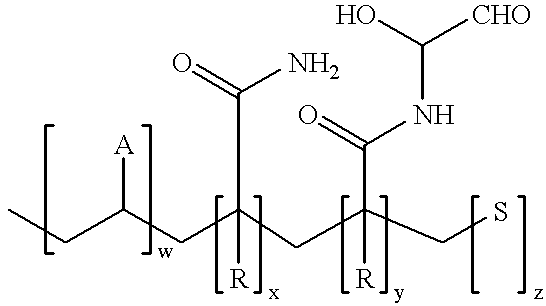Method of making soft bulky single ply tissue
- Summary
- Abstract
- Description
- Claims
- Application Information
AI Technical Summary
Benefits of technology
Problems solved by technology
Method used
Image
Examples
example 2
A one-ply tissue base sheet was made on a crescent former paper machine from a furnish containing 10% Northern Softwood Kraft, 40% Southern Hardwood Kraft, and 50% Secondary Fiber. Twelve pounds per ton of a modified cationic starch (CoBond.RTM. 1600) was applied to the furnish to provide temporary wet strength. The furnish was also treated with 3.5 pounds per ton of an imidazoline-based softener (Arosurft.RTM. PA 806) to control tensile strength and impart softness. Two and one-half pounds per ton of a spray softener (Quasoft.RTM. 209JR) was applied to the sheet while it was on a pressing felt. The sheet was creped from the Yankee dryer at a moisture content of 4 percent. The crepe angle was 73.5 degrees and the percent reel crepe was 25%. The sheet was calendered such that the caliper of the uncalendered tissue base sheet was reduced by approximately 20-25%. The physical properties of the tissue base sheet are shown in Table 2.
The base sheet was converted to a singleply tissue pro...
example 3
As has been shown in the previous example, it is difficult, using the prior art, to produce a soft, CWP one-ply product from a furnish containing high percentages of coarse Southern fiber and / or recycled fiber. Because of this difficulty, most premium tissue products made from these furnish types have been produced in a two-ply format. In order to compare the one-ply product of the current invention with two-ply technology a two-ply tissue product of similar basis weight to that of the one-ply tissue products; was produced using the same furnish blend. For the two-ply product, no temporary wet strength agent or softening compounds were added to the furnish, as these chemicals are not typically included in two-ply tissue products. The tissue base sheet was creped from the Yankee dryer at a moisture content of 4%, a percent crepe of 20% and creping angle of 73.5 degrees. The base sheets were calendered to a targeted caliper of 29 mils / 8 sheets.
Two base sheets were plied together and e...
example 4
The product of the current invention exhibits higher embossed CD stretch as compared to products embossed using prior art technology. This higher CD stretch results in a more flexible product and one having a lower tensile stiffness in the cross machine direction. This lower CD stiffness is of particular importance for one-ply CWP products as the CD tensile stiffness is typically much higher than that of the machine direction and controls the overall product stiffness level.
Eight one-ply tissue base sheets having a variety of furnish blends were made on a crescent former paper machine. These base sheets were each embossed using conventional emboss technology and the technology of the current invention as described in Example 2. The physical properties of the base sheets and finished products were measured. FIG. 8 shows the CD stretch of the embossed tissues as a function of their base sheet CD stretches. The figure shows that the emboss technology of the current invention provides a...
PUM
| Property | Measurement | Unit |
|---|---|---|
| Angle | aaaaa | aaaaa |
| Angle | aaaaa | aaaaa |
| Length | aaaaa | aaaaa |
Abstract
Description
Claims
Application Information
 Login to View More
Login to View More - R&D
- Intellectual Property
- Life Sciences
- Materials
- Tech Scout
- Unparalleled Data Quality
- Higher Quality Content
- 60% Fewer Hallucinations
Browse by: Latest US Patents, China's latest patents, Technical Efficacy Thesaurus, Application Domain, Technology Topic, Popular Technical Reports.
© 2025 PatSnap. All rights reserved.Legal|Privacy policy|Modern Slavery Act Transparency Statement|Sitemap|About US| Contact US: help@patsnap.com



